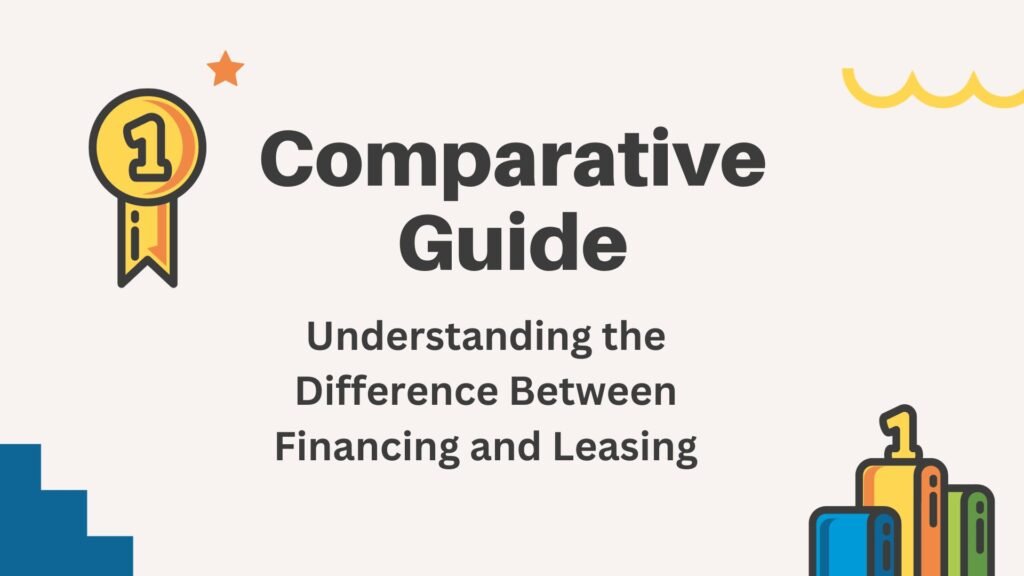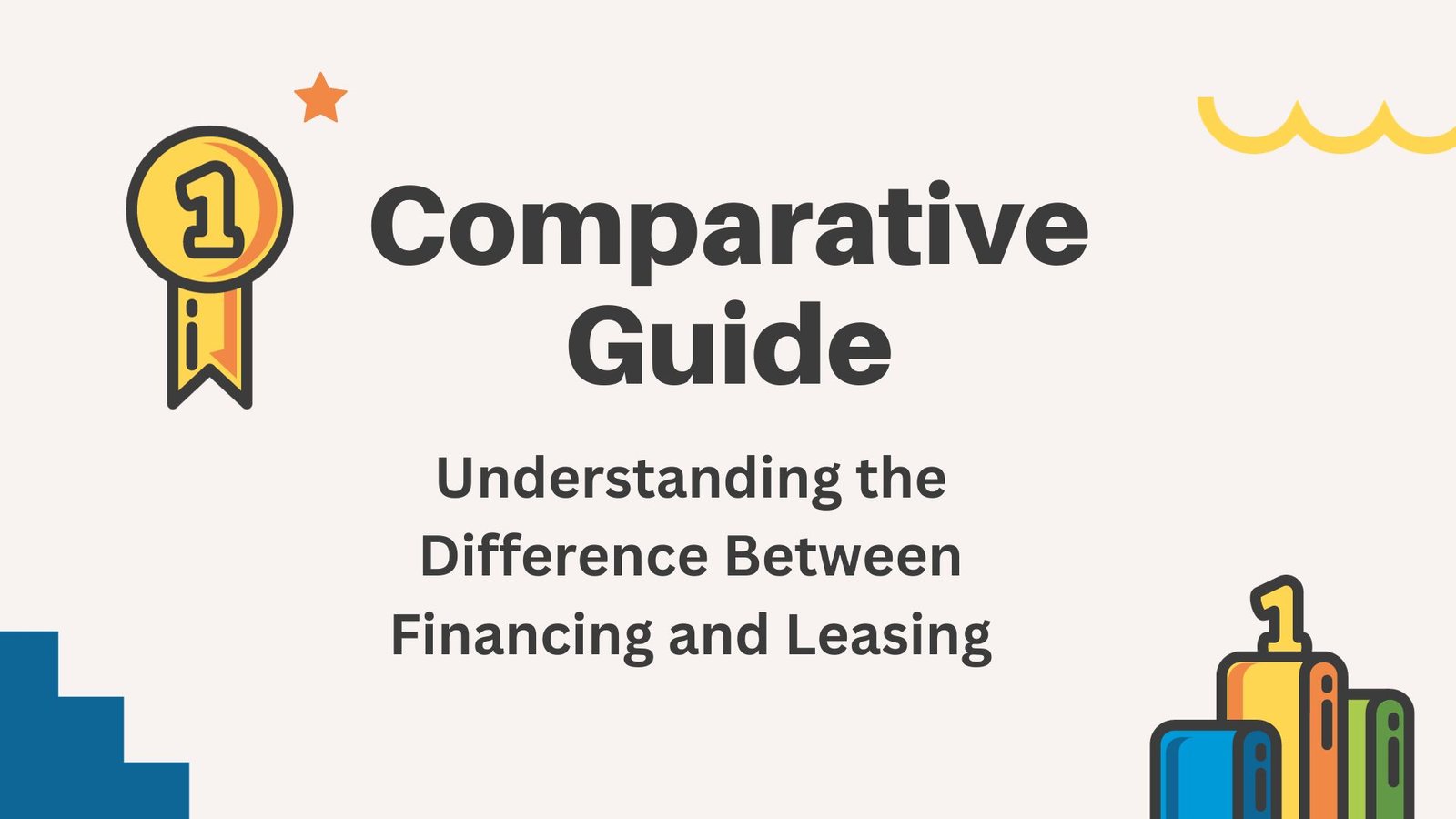Comparative Guide: When it comes to purchasing a new vehicle, there are two primary options to consider: financing and leasing. While they both provide a means to acquire a vehicle, it’s crucial to understand the differences between these two methods before making a decision.
In this comparative guide, we will delve into the basics of financing and leasing, discuss the importance of knowing the difference, and explore the factors that should be taken into account during the decision-making process.
Comparative Guide

Financing: Know Your Options | Comparative Guide
A. Definition and Mechanics of Financing
Financing a vehicle involves obtaining a loan from a financial institution or a car dealership to pay for the purchase price of the vehicle. This loan is then repaid over a specified period, usually in monthly installments, until the full amount is paid off. The lender typically holds the title to the vehicle as collateral until the loan is fully satisfied.
B. Advantages of Financing
1. Ownership and Equity Building
One of the key advantages of financing a vehicle is that you ultimately own the car once the loan is repaid. As you make monthly payments, your equity in the vehicle steadily increases. With each payment, you are building ownership and increasing your net worth.
2. Flexibility and Customization
When you finance a vehicle, you have the freedom to customize and modify it as you please. You can add aftermarket parts, paint the exterior, or install a customized sound system without any restrictions. This flexibility allows you to truly make the vehicle your own.
3. Tax Benefits and Deductions
Another significant advantage of financing a vehicle is the potential for tax benefits. In some cases, the interest paid on the car loan may be tax-deductible, which can help reduce your overall tax liability. Additionally, if you use the vehicle for business purposes, you may be eligible for additional tax deductions.
C. Drawbacks of Financing
1. Higher Monthly Payments | Comparative Guide
One drawback of financing is that it often leads to higher monthly payments compared to leasing. Since you are responsible for paying off the full purchase price of the vehicle, the monthly installments can be higher, especially if you choose a shorter loan term.
2. Depreciation and Resale Value Concerns | Comparative Guide
Vehicles tend to depreciate over time, which means their value decreases. When you finance a vehicle, you bear the risk of depreciation and potential resale value concerns. If the vehicle depreciates faster than expected, you may owe more on the loan than the car is worth if you decide to sell it before the loan is paid off.
3. Maintenance and Repair Costs | Comparative Guide
As the owner of a financed vehicle, you are responsible for all maintenance and repair costs. While newer vehicles may come with warranties that cover some repairs, as the vehicle ages, you may find yourself incurring significant expenses for routine maintenance and unforeseen repairs.
Leasing: A Closer Look | Comparative Guide
A. Definition and Key Features of Leasing
Leasing a vehicle, on the other hand, involves essentially renting the vehicle for a specific period. Instead of obtaining a loan to purchase the car, you make monthly payments to the leasing company in exchange for the right to use the vehicle for an agreed-upon timeframe.
B. Advantages of Leasing
1. Lower Monthly Payments | Comparative Guide
One of the most enticing advantages of leasing is the lower monthly payments compared to financing. Since you are only paying for the depreciation and the portion of the vehicle’s value that you use during the lease term, the monthly payments are generally lower.
2. Ability to Upgrade Frequently | Comparative Guide
Leasing allows you to drive a new vehicle every few years. When the lease term expires, you can simply return the vehicle to the leasing company and choose a new model, without the hassle of selling or trading in a vehicle. This flexibility enables you to enjoy the latest car models with the latest features.
3. Lower Maintenance Costs | Comparative Guide
Since lease agreements typically cover the duration of the manufacturer’s warranty, you may be able to avoid costly repair and maintenance expenses. Basic routine maintenance is usually included, such as oil changes and tire rotations, minimizing your out-of-pocket costs.
C. Drawbacks of Leasing
1. Lack of Ownership and Equity | Comparative Guide
Perhaps the most significant drawback of leasing is that you do not own the vehicle. At the end of the lease term, you must return the car to the leasing company, and you have no equity built up in the vehicle. This means you do not get any return on your investment like you would with financing.
2. Mileage Restrictions and Penalties | Comparative Guide
Lease agreements often come with mileage restrictions, which limit the number of miles you can drive during the lease term. If you exceed these limits, you may be subject to substantial penalties. This can be a significant concern for individuals with long commutes or who frequently travel long distances.
3. Limited Customization Options | Comparative Guide
Since you do not own the leased vehicle, customization options are typically limited. Most leasing companies require the vehicle to be returned in its original condition, without any modifications. This lack of customization can be a disadvantage for those who enjoy personalizing their vehicles.
Making the Right Decision: Factors to Consider | Comparative Guide
When deciding whether to finance or lease a vehicle, several factors should be taken into consideration. These factors can be grouped into two main categories: financial considerations and individual needs and lifestyle factors.
A. Financial Considerations
1. Budget and Cash Flow
Analyzing your budget and cash flow is crucial when deciding between financing and leasing. Consider how much you can comfortably afford in monthly payments and how it fits into your overall financial situation.
2. Long-Term Goals and Financial Outlook
Examine your long-term goals and financial outlook. If you prefer driving a new vehicle every few years and have no desire for long-term ownership, leasing might align better with your goals. However, if you value ownership and building equity, financing might be the better choice.
3. Credit History and Interest Rates
Your credit history plays a significant role when financing a vehicle. A good credit score can help you secure a lower interest rate, potentially reducing your overall loan costs. If you have a less-than-ideal credit score, leasing may be a more accessible option, as credit requirements for leases are typically less strict.
B. Individual Needs and Lifestyle Factors
1. Vehicle Usage and Mileage
Consider how you plan to use the vehicle and your estimated mileage. Frequent long-distance travel or a high-intensity usage pattern might make leasing less practical due to mileage restrictions.
2. Duration of Vehicle Use
Think about the duration you intend to use the vehicle. If you prefer long-term ownership and do not mind driving the same car for several years, financing may be the better choice. However, if you prefer driving the latest models and enjoy the novelty of a new car more frequently, leasing may suit your preferences.
3. Customization and Personalization Preferences
Evaluate your desire for customization and personalization. If you enjoy modifying your vehicle to your liking, financing provides more freedom in this aspect. However, if you don’t mind driving a vehicle in its original condition, leasing may be a viable option.
C. Future Plans and Flexibility
1. Estimated Vehicle Resale Value
If you anticipate selling the vehicle in the future, consider the potential resale value. Financing allows you to build equity over time, potentially yielding a higher return on your investment when you decide to sell. Leasing, on the other hand, does not provide this opportunity, as you do not own the vehicle.
2. Expected Changes in Transportation Needs
Reflect on any anticipated changes in your transportation needs. If your circumstances might change in the near future, such as a new job or a growing family, leasing could provide more flexibility to adapt to these changes.
3. Adaptability to Changing Circumstances
Consider your adaptability to changing circumstances. Leasing offers flexibility if your lifestyle or preferences change frequently. However, if you prefer consistency and stability, financing a vehicle may align better with your needs.
Conclusion Of Comparative Guide
A. Recap of Financing and Leasing Differences
In summary, financing involves obtaining a loan to purchase a vehicle, providing ownership and the potential for equity building, while leasing involves renting a vehicle for a specified period, providing lower monthly payments and flexibility to upgrade frequently. Each method has its advantages and drawbacks that should be carefully evaluated.
B. Decision-Making Guidelines
When deciding between financing and leasing, consider the financial aspects, including budget, long-term goals, and credit history, as well as individual needs such as vehicle usage, duration of use, customization preferences, future plans, and adaptability to changing circumstances. By carefully considering these factors, you can make a more informed decision.
C. Understanding the Impact on Personal and Financial Aspects
Ultimately, the decision between financing and leasing a vehicle has a significant impact on both personal and financial aspects. Understanding the differences and evaluating your specific circumstances will help ensure that you choose the option that aligns best with your needs, preferences, and goals.
FAQs (Frequently Asked Questions) About Comparative Guide
- Can I finance a used vehicle?
- Yes, it is possible to finance a used vehicle. Many financial institutions offer loans for used cars, although the terms and interest rates may differ from those for new vehicles. It’s important to research and compare loan options for used cars to ensure you secure the most favorable terms.
- What happens at the end of a lease term?
- At the end of a lease term, you are typically required to return the vehicle to the leasing company. You may have the option to negotiate a lease extension or purchase the vehicle at a predetermined price. It’s important to carefully review the lease agreement to fully understand the options available to you.
- Are there any tax benefits associated with leasing?
- While leasing a vehicle may not provide the same tax benefits as financing, there are certain circumstances where lease payments can be partially tax-deductible. If you use the leased vehicle for business purposes, consult with a tax professional to determine if you are eligible for any tax deductions.
- Can I negotiate the terms of a lease agreement?
- Yes, lease terms are often negotiable. It’s worth exploring the possibility of negotiating factors such as the monthly payment, the length of the lease term, mileage restrictions, and the residual value of the vehicle. Working with a knowledgeable leasing professional can help you negotiate terms that better suit your needs.
- Is leasing always a cheaper option than financing?
- Leasing can provide lower monthly payments compared to financing, but it may not always be the cheaper option. When leasing, you are essentially paying for the depreciation of the vehicle, and you do not build equity. Financing, on the other hand, allows you to build ownership and potentially yield a higher return on investment when selling the vehicle. It’s essential to evaluate the long-term costs and benefits of both options to determine which is more cost-effective for your specific situation.
